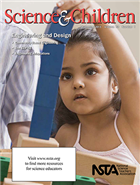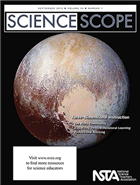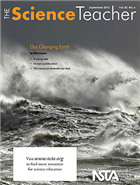Ideas from NSTA September K–12 journals
By Mary Bigelow
Posted on 2015-09-20
 Science and Children: Engineering and Design
Science and Children: Engineering and Design
Engineering and design are naturals for younger students. Just watch them play, invent things, and solve problems. The articles this month focus on these topics and how models (whether physical, two-dimensional, or mental) are important to the engineering and design process.
- Scampering Into Engineering! 5E learning-cycle mini-lessons in the library extend students’ experiences in designing and testing cars.
- Gimme an “E”! Here are seven strategies to support engineering practices in the classroom.
- Designing a Sound-Reducing Wall Extend studnets’ understanding of sound with a design challenge that fits in a shoe box. Science 101: How Do Acoustics Dictate the Design of a Concert Hall? has more information on the topic.
- The EDP-5E Adapt your 5E learning-cycle lessons, including Engineering as a substitute for Exploration.
- Engineering Encounters: Engineering Adaptations How can traditional science investigations be adapted to incorporate engineering design?
- Teaching Through Trade Books: Design Dilemmas Through stories and related activities, students in K-2 and 3-5 explore engineering and design processes used in solving problems and challenges.
- The Early Years: Integrating Design Students use their innate problem-solving abilities to create a system for moving materials from one place to another.
- Formative Assessment Probes: Where Do I Put the Switch? This probe examines students’ thinking about simple electric circuits.
- Methods and Strategies: Teaching in Real Time What does formative assessment “look like” during each step of the 5E learning cycle?
- Community-Based Engineering Students engage in “learning by doing” as they design and test solutions to a problem in a school garden.
[For more on the content that provides a context for these projects and strategies see the SciLinks websites for Inventions and Inventors, Simple Machines, Electric Current, Force and Motion, Sound Quality, Magnets, Magnetism, Mirrors]
Continue for Science Scope and The Science Teacher.
 Science Scope: Three-Dimensional Instruction
Science Scope: Three-Dimensional Instruction
As the editor notes,” It will take many lessons with various combinations and blendings of SEPs, CCs, and DCIs to get students to reach the competency goal of each performance expectation.” The NSTA journals show us many examples of how lessons and resources can incorporate the 3-Ds (Science and Engineering Practices, Cross-Cutting Concepts, and Disciplinary Core Ideas).
- The Controversy Over Pluto: Planet or Astronomic Oddball? The recent New Horizons mission is providing us with more data about Pluto. Remember when Pluto’s status was changed from planet to dwarf planet? Learn how studying scientific controversies can support scientific argumentation and increase science literacy.
- Botanical Heart Throbs: Heart Rate in Blackworms In this 5E learning-cycle lesson, students explore the effects of plant abstracts on the heart rate.
- Using Professional Noticing to Address Middle Level Students’ Alternative Conceptions of Lunar Phases How can we identify student misconceptions and help their understanding.
- Exploring the Science of Less-Familiar Forms of Animal “Flight” With these lessons, students explore other types of animal motion–falling, parachuting, and gliding.
- Everyday Engineering: Keeping It Together—Fascinating Fasteners In this 5E learning-cycle lesson, students design, construct and test types of fasteners.
[For more on the content that provides a context for these projects and strategies see the SciLinks websites for Planets, Space Exploration, Earth’s Moon, Moon Phases, Adaptations of Animals, Gravity, Design, Nervous System, Medicine from Plants, Earthworms]
The Science Teacher: Our Changing Earth
“Stability and Change” is one of the cross-cutting concepts in the NGSS. The editor raises the question about how much responsibility human activity has in changes that we see these days–in terms of population, urbanization, transport of invasive species, extraction industries, and pollution.
- A Rising Tide Students model the effects of global warming on the Earth’s oceans and predict sea level rise due to thermal expansion.
- Ocean Acidification In these six lessons, students examine the causes of ocean acidification and use a systems approach to this global problem from the perspective of several stakeholders.
- The Resource Beneath Our Feet Students investigate how a diversity of soils supports a diversity of organisms and how changes in can affect biodiversity and the health of an ecosystem.
[For more on the content that provides a context for these projects and strategies see the SciLinks websites for Sea Level Change, Causes of Climate Change, Acid Precipitation, Carbon Cycle, Soil, Soil Types]
Disclaimer: The views expressed in this blog post are those of the author(s) and do not necessarily reflect the official position of the National Science Teaching Association (NSTA).



